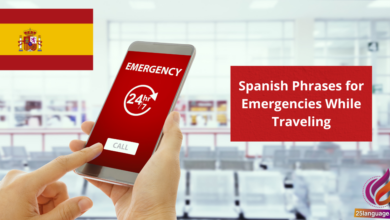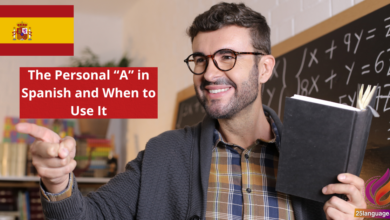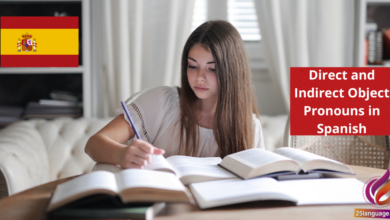Spanish Indirect Speech and Reported Speech

Imagine you’re sharing an exciting story about a friend’s adventure in a Spanish-speaking country. To convey what they said, you’d need to master the art of indirect and reported speech! In this lesson, we’ll explore how to convey thoughts and conversations smoothly in Spanish, enhancing your storytelling skills.By the end, you’ll confidently transform direct quotes into engaging narratives, making your Spanish both dynamic and compelling! Let’s dive in!
Understanding Spanish Indirect Speech for Effective Communication
Indirect speech in spanish, also known as reported speech, allows speakers to convey what someone else has said without quoting them directly. This form requires a shift in verb tenses when reporting statements. The basic rule of thumb is to backshift the verb tense, meaning that a present tense in direct speech changes to a past tense in reported speech. Such as:
- Direct: Él dice: “Voy a la tienda.” (He says: “I am going to the store.”)
- Indirect: Él dice que: “Iba a la tienda.” (He says that he was going to the store.)
Additionally,pronouns and time expressions frequently enough change in indirect speech. The pronoun shifts from the first person to the third person, and phrases like “hoy” (today) change to “ese día” (that day). Here are some more examples:
| Spanish Example | Direct Speech | Indirect Speech |
|---|---|---|
| Ella dijo: “estoy feliz.” | “I am happy.” | Ella dijo que estaba feliz. |
| Nosotros pensamos: “Vamos a estudiar.” | “We are going to study.” | Nosotros pensamos que íbamos a estudiar. |
| Él comentó: “Quiero viajar.” | “I want to travel.” | Él comentó que quería viajar. |
Navigating Reported Speech techniques in Spanish Language
Reported speech, or estilo indirecto, is essential for transforming direct quotes into a more summarized version in Spanish.The main rules to consider when using reported speech include the change in verb tenses and pronouns. when you report what someone else has said, the tense often shifts back one step. Such as, the present indicative changes to the imperfect, present perfect becomes past perfect, and the future becomes conditional. Here are some examples:
- Direct: Ellos dicen: “Vamos al cine.” (They say: “We are going to the movies.”)
- Reported: Ellos dicen que van al cine. (They say that they are going to the movies.)
- Direct: Maria dijo: “Tengo un perro.” (Maria said: “I have a dog.”)
- Reported: Maria dijo que tenía un perro. (Maria said that she had a dog.)
Another key aspect of reported speech involves adjusting the pronouns and adverbs depending on the context.Pronouns change according to the viewpoint of the speaker, and time indicators need to be altered to fit the timing of the reported statement. As a notable example, the adverb ahora (now) changes to entonces (then), and aquí (here) changes to allí (there). Below is a table illustrating some transformations:
| Direct Speech | Reported Speech | Translation |
|---|---|---|
| Él dice: “Estoy cansado.” | Él dice que está cansado. | He says: “I am tired.” |
| Ella dijo: “iré al mercado.” | Ella dijo que iría al mercado. | She said: “I will go to the market.” |
| Nosotros dijimos: “Estaremos listos.” | Nosotros dijimos que estaríamos listos. | We said: “We will be ready.” |
Mastering the Art of Quoting: Indirect Speech in Spanish Contexts
Indirect speech, or reported speech, is essential for expressing what someone else has said without quoting them directly. In Spanish, transforming direct quotes into indirect speech involves various grammatical adjustments. A key aspect to remember is that the verb tense often shifts back. As an example, the present tense in direct speech typically changes to the imperfect tense in indirect speech. Such as:
- Direct speech: Ella dice, “Voy a la tienda.”
(She says, “I am going to the store.”) - Indirect speech: Ella dice que iba a la tienda.
(She says that she was going to the store.)
Moreover, certain words and expressions within the sentence may also change to fit the context of the indirect speech. As a notable example, pronouns and adverbs of time need to align with the perspective of the speaker. here are more examples illustrating this transformation:
| Direct Speech | Indirect speech | Translation |
|---|---|---|
| Él dice, “Estoy cansado.” | Él dice que estaba cansado. | He says, “I am tired.” / He says that he was tired. |
| Nosotras pensamos, “Vamos a estudiar.” | Nosotras pensamos que íbamos a estudiar. | We think, “We are going to study.” / We think that we were going to study. |
| Ella afirmó, “Te llamaré mañana.” | Ella afirmó que te llamaría al día siguiente. | She said, “I will call you tomorrow.” / She said that she would call you the next day. |
Practical Approaches to Spanish Reported Speech with Real-Life Examples
Reported speech, or “el estilo indirecto,” is a way to convey what someone else has said without quoting them directly. In spanish, the verbs often shift in tense when reporting speech. The general rules for transforming direct speech into reported speech include:
- Changing present tense to past tense: “Ella dice que viene.” (She says that she is coming.) becomes “Ella dijo que venía.” (She said that she was coming.)
- Modifying pronouns: “Yo quiero eso.” (I want that.) becomes “Él dijo que quería eso.” (He said that he wanted that.)
- Adapting time expressions: “Hoy” (today) changes to “ese día” (that day). So, “Ella dijo que estaba ocupada hoy.” (She said that she was busy today.) becomes “Ella dijo que estaba ocupada ese día.”
When constructing reported speech,one must also keep the context in mind to ensure clarity. Here are a few more examples:
- “Tú tienes que estudiar más.” (you have to study more.) becomes “Ella dijo que tenías que estudiar más.” (She said that you had to study more.)
- “nos vamos de vacaciones la próxima semana.” (We are going on vacation next week.) becomes “Él dijo que se iban de vacaciones la semana siguiente.” (He said that they were going on vacation the following week.)
| Direct Speech | Reported Speech | Translation |
|---|---|---|
| “Quiero un café.” | “Ella dijo que quería un café.” | “She said that she wanted a coffee.” |
| “Estudia para el examen.” | “Él dijo que estudiaras para el examen.” | “He said that you should study for the exam.” |
| “vamos al cine esta noche.” | “Ellos dijeron que iban al cine esa noche.” | “They said that they were going to the cinema that night.” |
The Way Forward
Conclusión de la Lección: Estilo Indirecto y Discurso Reportado en Español
¡Felicitaciones por completar esta lección sobre el estilo indirecto y el discurso reportado en español! Hoy hemos explorado cómo expresar lo que otros han dicho sin citar sus palabras textualmente. Aprendimos la diferencia entre el discurso directo, donde se repite exactamente lo que alguien dijo, y el discurso indirecto, que nos permite reformular las ideas con nuestras propias palabras.
Hemos visto que es crucial prestar atención a los cambios que ocurren en los tiempos verbales,pronombres y otros elementos clave cuando transformamos el discurso directo en indirecto. También discutimos ejemplos prácticos que te ayudarán a integrar esta habilidad en tus conversaciones y escritos en español.
Ahora es el momento de aplicar lo que has aprendido. Practica convirtiendo frases de discurso directo a indirecto, ya sea en tus diálogos cotidianos o escribiendo un breve relato. Recuerda, la práctica constante es la clave para mejorar. no dudes en hablar en español, ya que cada intento te acercará más a la fluidez.
¡Sigue adelante y continua explorando el maravilloso mundo del español! Cada lección te acerca más a tus objetivos. ¡Buena suerte y hasta la próxima!





























